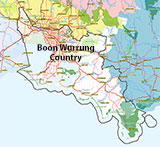Geoffs Hole
![]() Reef Dive |
Reef Dive | ![]() Boat access
Boat access
![]()
![]()
![]()
![]()
![]()
Depth: 18 m (59 ft) to 40 m (131 ft)
Geoffs Hole was discovered and named after one of the great local diving identities, Geoff Cross. This dive site is close inshore to Point Nepean and can only be dived on slack water. The shallowest section runs south-west to north-east with the deeper section to the south-east.
There have been reports that the wreck of a couta boat can be seen in this area. But with sand movement, it may be covered up.
This dive makes a nice change to Portsea Hole. A great dive to do during strong southerlies, as this area is quite sheltered
Traditional Owners — This dive site is in the traditional Country of the Boon Wurrung / Bunurong people of the Kulin Nation. This truly ancient Country includes parts of Port Phillip, from the Werribee River in the north-west, down to Wilson's Promontory in the south-east, including the Mornington Peninsula, French Island and Phillip Island, plus Western Port. We wish to acknowledge the Boon Wurrung as Traditional Owners. We pay respect to their Ancestors and their Elders, past, present and emerging. We acknowledge Bunjil the Creator Spirit of this beautiful land, who travels as an eagle, and Waarn, who protects the waterways and travels as a crow, and thank them for continuing to watch over this Country today and beyond.
Geoffs Hole Location Map
Latitude: 38° 17.958′ S (38.2993° S / 38° 17′ 57.48″ S)
Longitude: 144° 40.568′ E (144.676133° E / 144° 40′ 34.08″ E)
Datum: WGS84 |
Google Map
Added: 2012-07-22 09:00:00 GMT, Last updated: 2022-03-27 17:09:29 GMT
Source: GPS
Nearest Neighbour: Cattle Jetty Drift, 452 m, bearing 124°, SE
Depth: 18 to 40 m.
Dive only on: SWF, SWE.
[ Top ]
DISCLAIMER: No claim is made by The Scuba Doctor as to the accuracy of the dive site coordinates listed here. Should anyone decide to use these GPS marks to locate and dive on a site, they do so entirely at their own risk. Always verify against other sources.
The marks come from numerous sources including commercial operators, independent dive clubs, reference works, and active divers. Some are known to be accurate, while others may not be. Some GPS marks may even have come from maps using the AGD66 datum, and thus may need be converted to the WGS84 datum. To distinguish between the possible accuracy of the dive site marks, we've tried to give each mark a source of GPS, Google Earth, or unknown.


